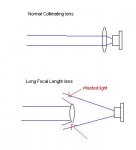No LaserBee, you misunderstood me.
Of course it can collimate the beam, that's what it's made for. You can use this lens or any aspherical lens of the right properties to collimate a laser beam. I just said that the product is misrepresented.
It says:
- Increased power over AixiZ acrylics
- 10mm FL
Neither is true. The FL is closer to 27mm IIRC (it's been a while since i measured it), and the power of my 6x blu ray, which does 189mW after an AixiZ acrylics, after this lens in parallel focus was around 61-64mW.
That's because of the low NA (numerical apperture - determines how much of the diode's output a lens can collect). The NA is determined by the lenses FL and the lenses effective diameter.
As the light exits the diode it diverges rapidly. If you want a higher power, you need a lens at the right distance from the diode, with a high enough effective diameter to collect as much of the light "cone" as possible. Ideally the NA of the lens should be the same as, or higher than the NA of the diode. That way the lens will collect all of the diode's output. It is then, that material and coatings come into play and can increase the power.
But when a lens is 27mm away from the diode it would need a huge effective diameter, to collect all or even most of the light. Since the lens is around 6.3mm diameter, it's effective diameter is around <5mm. At 27mm FL this means a VERY low NA, very little light collection. Sure, it passes the part of the light it collects better than other lenses, but it collects very little. Especially, if you consider the fact, that the fast axis of a 405nm diode spreads so fast, that it hits the inner threads of the AixiZ module, before it can even leave it. A good lens has to sit close enough to capture the light before it spreads over the lenses effective diameter.
There is one part of the description, that is true. The "round dot". Sometimes, when you want a diode laser with a round dot, you can use a lens with a lower NA. That will result in the edges of the fast axis of the diode output to be "clipped", and only the middle will get collimated. The result will be a round beam, but with some lost power. This is assuming, that the NA is low enough to clip some of the fast axis, but not low enough to clip the slow axis. That would be a NA of around 0.2 for a 405nm diode.. The beam would still not be perfectly round, but rounder, than we are used to.
But when a low diameter lens is 27mm away from the diode for parallel focus, or even if it was really 10mm, both the fast and the slow axis will get clipped resulting in a PERFECTLY round beam with a diameter of the lenses clear apperture, but with huge losses - that's why the beam is round, everything else is lost, and in this case, more than needed for a perfectly round dot is lost..
Because of that, it is not true, that this lens can increase the power. Sure, it could increase the power compared to an uncoated lens of the same FL and NA. But not compared to an AixiZ acrylics, which while it has far greater losses in material and reflections, at least collects most of the diode's output.
If you want to increase the power a little, you need either higher NA or better material + coating. If you want to increase the power a lot, you need higher NA and better material + coating.
When the diameter of the lens is limited (as is the case in our modules), the only way to get higher NA is by using a shorter FL.
This lens does have a higher transmittance than an AixiZ acrylics, but it can only produce a higher power beam, if that beam is passed to it with just the right divergence by another lens. Not by standing in front of a diode by itself.
So to sum it up. The product description is deceitful.
If the description would say "high transmittance material, x-y coating, low NA for a round beam", then it would not be a lie. But it says "higher power than AixiZ acrylics", which is not true. You can't have a clipped round beam and a higher power at the same time.





